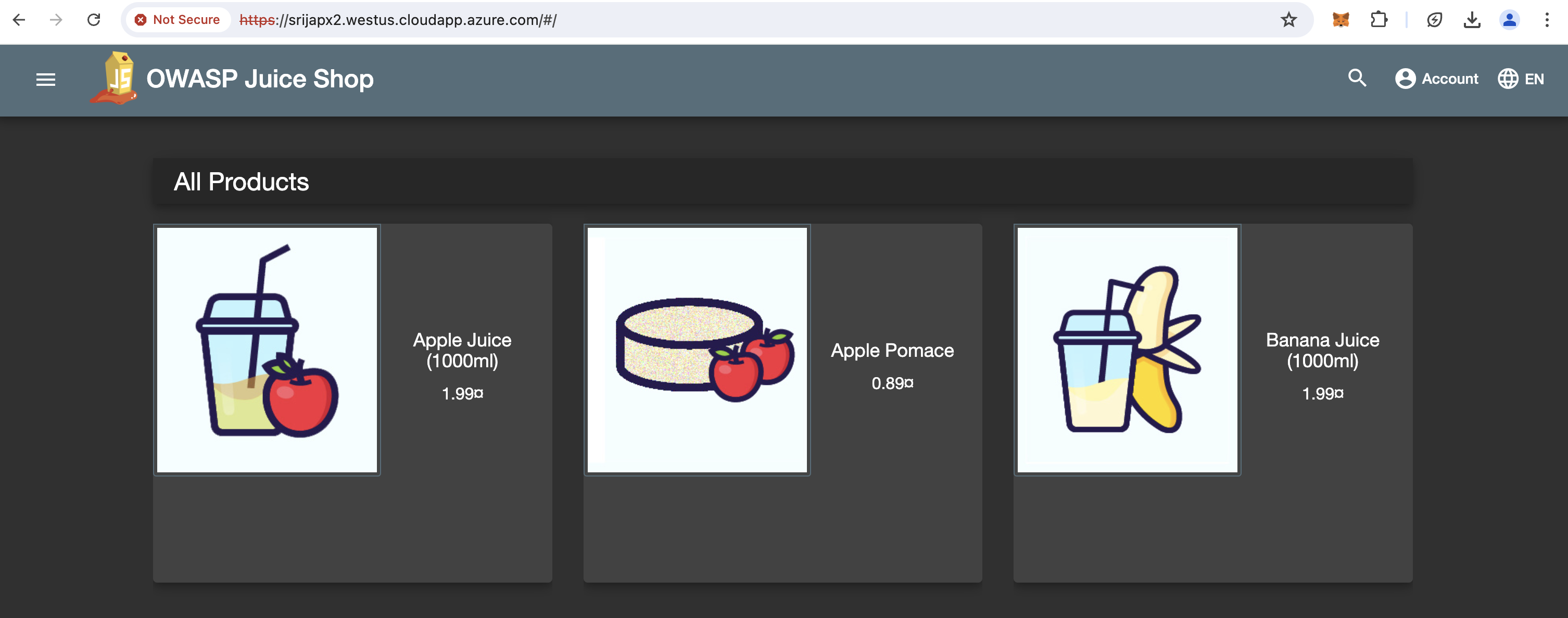Attack
Now lets create some attacks and defenses
SETUP
- For that lets create a deployment and Service for Juiceshop application.
cat << EOF | tee > juiceshopdeployment.yaml
apiVersion: apps/v1
kind: Deployment
metadata:
name: juiceshop-app
spec:
selector:
matchLabels:
app: juiceshop
template:
metadata:
labels:
app: juiceshop
spec:
containers:
- name: juiceshop
image: "bkimminich/juice-shop:snapshot"
EOF
kubectl apply -f juiceshopdeployment.yaml- Expose the application with a service.
cat << EOF | tee > juiceshopservice.yaml
apiVersion: v1
kind: Service
metadata:
name: juiceshop
labels:
app: juiceshop
spec:
type: NodePort
selector:
app: juiceshop
ports:
- port: 80
targetPort: 3000
protocol: TCP
EOF
kubectl apply -f juiceshopservice.yaml- Now lets add another path in ingress controller config to get to Juicehsop. Since its already deployed in the previous chapter, lets just update the 08_tls-ingress.yaml file and apply the config.
echo vm_name=$vm_name
rsakeyname="id_rsa_tecworkshop"
ssh-keygen -f "${HOME}/.ssh/known_hosts" -R "${vm_name}"
output=$(ssh -o "StrictHostKeyChecking=no" azureuser@$vm_name -i ~/.ssh/$rsakeyname 'get system interface')
echo $output
if [ "$fortiwebdeploymode" == "twoarms" ]; then
portName="port2"
else
portName="port1"
fi
portip=$(echo "$output" | grep -A 7 "== \[ $portName \]" | grep "ip:" | awk '{print $2}' | cut -d'/' -f1)
echo $portip
portip_first3=$(echo "$portip" | cut -d'.' -f1-3)
cat << EOF | tee > 08_tls-ingress.yaml
apiVersion: networking.k8s.io/v1
kind: Ingress
metadata:
name: m
annotations: {
"fortiweb-ip" : $portip,
"fortiweb-login" : "fwb-login1",
"fortiweb-ctrl-log" : "enable",
"virtual-server-ip" : $portip_first3.100,
"virtual-server-addr-type" : "ipv4",
"virtual-server-interface" : $portName,
"server-policy-web-protection-profile" : "ingress tls profile",
"server-policy-https-service" : "HTTPS",
"server-policy-http-service" : "HTTP",
"server-policy-syn-cookie" : "enable",
"server-policy-http-to-https" : "disable"
}
spec:
ingressClassName: fwb-ingress-controller
tls:
- hosts:
- $fortiwebvmdnslabelport2
secretName: tls-secret
rules:
- host: $fortiwebvmdnslabelport2
http:
paths:
- path: /info
pathType: Prefix
backend:
service:
name: service1
port:
number: 1241
- path: /
pathType: Prefix
backend:
service:
name: juiceshop
port:
number: 80
EOFThis is will update and generate the 08_tls-ingress.yaml file
- Now lets run
kubectl apply -f 08_tls-ingress.yaml
output:
ingress.networking.k8s.io/m configured.- the ingress controller will now have two paths. we can check by running:
kubectl get ingress
output:
srija [ ~/k8s-202-workshop/scripts/labEnv ]$ kubectl get ingress
NAME CLASS HOSTS ADDRESS PORTS AGE
m fwb-ingress-controller srijapx2.westus.cloudapp.azure.com 10.0.1.5 80, 443 158mkubectl describe ingress m
output:
Name: m
Labels: <none>
Namespace: default
Address: 10.0.1.5
Ingress Class: fwb-ingress-controller
Default backend: <default>
TLS:
hello-app-tls terminates srijapx2.westus.cloudapp.azure.com
Rules:
Host Path Backends
---- ---- --------
srijapx2.westus.cloudapp.azure.com
/ juiceshop:80 (10.224.0.8:3000)
/info service1:1241 (10.224.0.14:9876)
Annotations: FortiWeb-ctrl-log: disable
FortiWeb-ip: 10.0.1.4
FortiWeb-login: fwb-login1
server-policy-http-service: HTTP
server-policy-http-to-https: disable
server-policy-https-service: HTTPS
server-policy-syn-cookie: enable
server-policy-web-protection-profile: Inline Standard Protection
virtual-server-addr-type: ipv4
virtual-server-interface: port1
virtual-server-ip: 10.0.1.5
Events: <none>- In the web browser:
- if you try going to https://hostname/
- it will redirect to juiceshop,
- https://hostname/info
- will redirect to service1.
example:
https://srijapx2.westus.cloudapp.azure.com/

